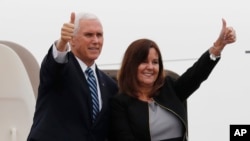美国副总统彭斯东盟赴会强调美国承诺
美国副总统彭斯前往新加坡参加地区峰会,期间他将强调特朗普政府致力于保持印度洋太平洋地区的自由和开放。与会领导人将密切关注他在安全、贸易和投资等方面能提供的实际帮助。
一位高级政府官员在向记者介绍情况时表示,彭斯副总统这次东南亚之行将公布“具体,实质性举措”,以实现特朗普总统去年在越南岘港举行的亚太经合组织会议上所阐述的“自由开放的印度-太平洋”战略。
该战略的重点是实现这一地区的市场自由和航行自由,取代奥巴马时代将美国在欧洲和中东的战略“重新平衡”的“转向亚洲”政策。
彭斯今年10月份在哈德逊研究所的演讲中指出,中国国家主席习近平推行的“一带一路”倡议是“债务陷阱外交”。
彭斯在亚洲之际可能会强调美国的替代方案,即美国国际开发金融公司(USIDFC),一个根据两党法案创建的新机构。其新的600亿美元计划支持私人投资全球基础设施项目。
马尔代夫、斯里兰卡和马来西亚是一些对一带一路投资进行重新考虑的国家,原因是批评者所称的中国债务陷阱所引起的问题。北京否认相关指控,包括其贷款带来了包括腐败、劳工违规和令人讨厌的债务等问题。
美国 - 东盟商业理事会政策副总裁Marc Mealy希望美国国际金融公司能够帮助美国商界成为东南亚“可行和可靠的替代商业伙伴”。
新加坡首脑会议关注的焦点之一是华盛顿与北京之间的贸易争端,这让东南亚国家感到不安。
美中关税战迫使这些国家重新考虑其商业战略,在各国的不同领域都有赢家和输家。
各国也在关注特朗普政府与该地区盟友的贸易和关税政策。在日本,彭斯推动日本首相安倍晋三达成双边贸易协议,特朗普总统希望该协议将削减东京与华盛顿的贸易顺差。
彭斯预计将在新加坡继续推动与越南和菲律宾在内的当地几个国家的双边自由贸易议程。
这可能与东南亚国家联盟(ASEAN)不一致,后者更愿意作为一个整体与贸易伙伴进行交易。
东盟已经与亚太地区的所有主要经济体签订了五项自由贸易协定,包括中国、日本、印度、韩国和新西兰。东盟正在努力将所有五个单独协议纳入一项称为区域全面经济伙伴关系(RCEP)的协议,如果最终完成,该协议将涵盖全球40%以上的人口。
各国也担心美中在台湾问题上的紧张关系以及在南中国海问题上的敌意日益加深,特别是鉴于最近美国迪凯特号与中国军舰鲁阳号几乎发生相撞事件。
中国总理李克强将出席在新加坡举行的东盟 - 中国峰会和东亚峰会,习近平主席将出席亚太经合组织会议。俄罗斯总统普京也将参加在新加坡和莫尔兹比港举行的峰会。
Pence in Asia to Highlight US Commitment
U.S. Vice President Mike Pence is in Singapore for regional summits during which he will highlight the Trump administration’s commitment to keeping the Indo-Pacific region free and open, but where leaders will be watching closely what he will actually offer, both on security as well as trade and investment.
In a briefing to reporters, a senior administration official said the vice president’s visit to the region will unveil “concrete, substantive initiatives” to fulfill the “Free and Open Indo-Pacific” strategy outlined by President Donald Trump in the Asia Pacific Economic Cooperation (APEC) summit in Da Nang, Vietnam, last year.
The strategy focuses on achieving free markets and freedom of navigation in the region, and replaces the Obama-era “pivot to Asia,” a strategic “re-balancing” of U.S. interests from Europe and the Middle East.
In his October speech at the Hudson Institute, Pence called Chinese President Xi Jin Ping's Belt and Road Initiative, “debt trap diplomacy.”
In Asia, he will likely highlight the American alternative, the U.S. International Development Finance Corporation (USIDFC), a new agency created under the bipartisan BUILD Act. The new $60 billion initiative supports private investments for infrastructure projects around the world.
The Maldives, Sri Lanka and Malaysia are some of the nations rethinking BRI investments because of problems arising from what critics see as a Chinese debt trap. Beijing denies the accusations that its loans create problems ranging from corruption, labor violations to objectionable debt.
Marc Mealy, vice president on policy at the US-ASEAN Business Council, a lobby group for American companies, hopes the USIDFC will help position the American business community as a “viable and credible alternative commercial partner” for Southeast Asia.
One of the issues in focus at the Singapore summits is the trade spat between Washington and Beijing, which has left countries in the region on edge.
The U.S.-Sino tariff wars have forced Southeast Asian nations to rethink their business strategy, and there have been winners and losers in different sectors of individual countries.
Countries are also watching the Trump administration’s trade and tariff policies with allies in the region. In Japan, Pence pushed Prime Minister Shinzo Abe for a bilateral trade agreement that President Trump hopes will cut Tokyo's trade surplus with Washington.
In Singapore, Pence is expected to continue the U.S. bilateral free-trade agenda with several countries in the region, including Vietnam and the Philippines.
This may be at odds with the Association of South East Asian Nations (ASEAN), which prefers to deal with trading partners as a regional block.
ASEAN already has five free-trade agreements with all of the major economies in Asia-Pacific, including China, Japan, India, South Korea and New Zealand. The regional block is trying to bring all five of the individual deals into a single agreement called the Regional Comprehensive Economic Partnership (RCEP) that, if concluded, would constitute more than forty percent of the world's population.
Countries are also concerned about U.S.-Sino tensions over Taiwan and rising hostility in the South China Sea, especially in light of a recent near-collision between the USS Decatur and the Chinese warship, Luyang.
Chinese Prime Minister Li Keqiang will attend the ASEAN – China Summit and the East Asia Summit in Singapore and President Xi Jinping will be at APEC. Russian President Vladimir Putin will also be going to the summits in Singapore and Port Moresby.
美国正失去对外国留学生的吸引力
美国仍然是留学生的首选目的地,目前有超过100万人,是排在其后的英国拥有的留学生人数的两倍多。但根据国际教育协会(IIE)年度开放门户报告的数据,去年来美留学生增加了1.5%,但新生入学率,特别是本科生,下降了6.6%,上一年也是同样的趋势。
教育工作者表示,美国公立大学每年的学费约为2万美元,精英私立大学的学费超过7万美元,在全球竞争加剧的情况下,这使得美国对国际学生的吸引力降低
国际教育协会的发言人凯瑟琳·莫里斯表示,65%的国际学生依赖“国际资金来源”,“超过一半的学生(59%)则靠自己的个人和家庭资助。”
在本科生中则有82%依靠个人和家庭资助。大多数外国学生不符合获得美国学校的经济援助的标准。
来自中国和印度的留学生占国际学生的近一半,分别为363,341人和196,271人。两年前印度的货币政策调整导致许多希望前往美国求学的学生失去了资金来源。而在国际学生中占主导的中国学生,据报道对身边的美国学生获得补贴而自己付全额学费越来越不满。
美国大学协会主席林恩帕斯克雷拉说,“目前的高等教育财政模式是不可持续的。”他说,“我们不能一直对国际提高学费或增加国内学生的贷款债务。”
US Losing Its Luster for Foreign Students
The U.S. remains the top destination in the world for more than 1 million visiting students — hosting more than double the next country, the United Kingdom. But while 1.5 percent more students studied in the U.S. last year, the rate of new enrollments — specifically, undergraduate students — declined by 6.6 percent, a trend first seen the preceding year, according to the Institute for International Education’s (IIE) annual Open Doors report.
Tuition costs of around $20,000 a year for public institutions to more than $70,000 for elite private universities, make the U.S. look less attractive to international students, as global competition increases, educators said.
65% of international students rely on “international funding sources” said IIE spokesperson Catherine Morris, “with well over half of all students (59 percent) funded through their own personal and family funding.”
Among undergraduates, 82 percent rely on personal and family funding. Most are not eligible for financial aid at U.S. schools.
China and India send nearly half of all international students, 363,341 and 196,271, respectively, to the U.S. A currency correction in India two years ago wiped out funding sources for many students there hoping to head to the U.S. And Chinese students, who dominate the population of international students, report growing discontent with paying full tuition next to subsidized domestic students.
“The current financial model for higher education isn’t sustainable,” offered Lynn Pasquerella, president of the Association of American Colleges and Universities. “We can’t raise tuitions and have burgeoning loan debts” for international or domestic students.







